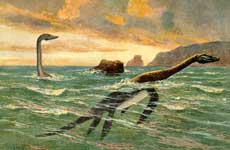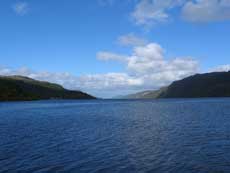As far back as the 7th Century, people have reported seeing a Loch Ness monster in Scotland. Can science explain these mysterious sightings?

The Loch Ness is a lake in Scotland that holds the largest volume of freshwater in the United Kingdom. But rather than being known for its size, it is famous for the mysterious legend of the Loch Ness monster. For hundreds of years, people have reported catching a glimpse of a huge creature in the lake while others have shared photos they claim to have taken of this sea creature. The legend is so great that even scientists have been intrigued and many have conducted experiments and come up with theories to try and explain what people could be witnessing.
A real creature in Loch Ness?
Table of Contents
It has been proposed that Nessie – as the Loch Ness monster is commonly called – could be a prehistoric creature called a plesiosaur, an animal that spanned up to ten meters in length and has long been considered to be extinct. Adrian Shine, the leader of a British team called the Loch Ness Project, has spent over 30 years trying to rationally explain the monster sightings by researching the ecology of the region. If in fact a large creature was living in the lake, there would have to be evidence of a food chain for it to survive. A creature like the Loch Ness monster would most likely eat fish, which in turn would live off large quantities of microscopic animals called zooplankton. There would have to be enough zooplankton in the lake to support populations of larger animals.
A way of estimating the amount of zooplankton in the lake is to examine the quantities of green algae – the bottom rung of the food chain – that zooplankton feed from. Green algae needs some light to thrive, and so by examining how deep down in the lake sunlight can penetrate, researchers can estimate the amount of green algae and following from this, the type of population that could be sustained.
Scientists have calculated that a maximum of 17 to 24 tons of fish live in the Loch Ness. For a lake of its size, it is a small amount, and would be able to keep alive about ten creatures weighing 226 kg each. According to Richard Forrest, an expert on plesiosaurs, ten creatures would not be enough to keep a colony going. “Thirty to forty creatures would be the minimum size of a breeding population,” he says.
In addition, if creatures similar to plesiosaurs lived in the waters of the Loch Ness, they would be seen very frequently as they would have to surface several times a day to breathe. Eye witnesses have often mentioned seeing an animal throwing back its long neck from the water, but Forrest claims that plesiosaurs couldn’t do that. “he simple fact is that a plesiosaur’s neck is too stiff. The bones of the neck interlock and there are tall spines on top of them so the neck can’t go straight out of the water” he says.
SONAR investigations
But it is not impossible for prehistoric creatures to still be around today. In 1938, South African fishermen caught a gigantic fish that turned out to be a Coelacanth, a prehistoric fish thought to be extinct for the past 80 million years. Because of murky water filled with peat, it has been hard for divers to properly investigate the depths of the Loch Ness and the life that exists there. The advent of SONAR – a measuring instrument that sends sound waves into water and measures distance by calculating the time it takes for an echo to travel back to the source – has proved to be useful for probing the mystery since the waves can detect any objects that come in their way.
In 1987, Operation Deepscan took place – the biggest SONAR exploration of Loch Ness. Boats equipped with SONAR were deployed across the whole width of the lake and they simultaneously sent out acoustic waves. BBC News reported that the scientists had made sonar contact with a large unidentified object of unusual size and strength. The researchers decided to return to the same spot and re-scan the area.
After analyzing the SONAR images, it seemed to point to debris at the bottom of the lake, although three of the pictures were of moving debris. Shine speculates that they could be seals that got into the lake, since they would be of about the same magnitude as the objects detected. But no one has been able to confirm their identity.
Similarly, many people have captured photos of monster-like creatures that have never been explained. Many have been dismissed as forgeries, but the most trusted one was called the Surgeon’s Photo, since it was supposed to be have been taken by well-respected surgeon Robert Wilson. For about 50 years, the true story behind the picture was a mystery, but it was finally revealed to be a hoax started by a man called Marmaduke Wetherall. Attempting to prove to the world that Nessie exists, Wetherall had already claimed to have found monster-sized footprints near the Loch, but when the casts he sent to the Natural History Museum in London were analysed, they were found to be hippopotamus tracks! As revenge, he made a model of the monster and photographed it on Loch Ness. He managed to persuade Wilson to pass it off as his own, since he knew that no one would believe him after his hippo prank.
Monster earthquakes?
Although many sightings could be hoaxes, there could also be a geological interpretation: seismic activity in the lake could cause disturbances on its surface that could be mistaken for Nessie. Loch Ness is situated on the Great Glen fault line that was created by the collision of continents that formed Scotland 400 million years ago. Over 200 years ago, a major earthquake with its epicenter in Lisbon, Portugal caused water disturbances in the Loch more than 1500 km away. “Reports state that a wave about two or three feet high was seen travelling up and down Loch Ness” says Robert Musson, the principal seismologist at the British Geological Survey. But he claims that generally there is little seismic activity in the area and doesn�t think that earthquakes can account for the repeated sightings.

Dr Luigi Piccardi, an Italian specialist in Mediterranean geology, disagrees. Currently studying events depicted in Greek mythology, he says that many of the effects described can be related to real effects during strong earthquakes. Similarly, he thinks that the same theory applies to Nessie and claims that there are recurring tremors around the town of Inverness just 16 kms away that could spread to the Loch. He plans to test his theory by conducting a detailed seismic survey in the area.
But should geological explanations fail, psychology may be able to provide some insight. Helen Ross, a psychologist and expert on illusions, thinks that myth is so powerful that people can convince themselves that an ordinary object floating in the water is a monster. “When something really ambiguous is there, people often don’t know what they’re seeing and they can see all sorts of strange things”, she says. “Its a bit like seeing faces in the fire or ink blots appearing as all sorts of creatures.”
Until physical evidence of the Loch Ness monster is found – like the creature itself or its skeleton – it may be hard to convince most scientists that it exists. Perhaps the sightings are simply an example of the human fascination for mystery and intrigue, and the awe that many people have for the natural world.
